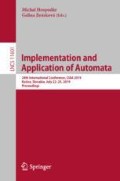Abstract
We consider the problem of partitioning effectively a given symmetric (and irreflexive) rational relation R into two asymmetric rational relations. This problem is motivated by a recent method of embedding an R-independent language into one that is maximal R-independent, where the method requires to use an asymmetric partition of R. We solve the problem when R is realized by a zero-avoiding transducer (with some bound k): if the absolute value of the input-output length discrepancy of a computation exceeds k then the length discrepancy of the computation cannot become zero. This class of relations properly contains the recognizable, the left synchronous, and the right synchronous relations. We leave the asymmetric partition problem open when R is not zero-avoiding. We also show examples of total word-orderings for which there is a relation R that cannot be partitioned into two asymmetric rational relations with respect to the given word-orderings.
Access this chapter
Tax calculation will be finalised at checkout
Purchases are for personal use only
Notes
- 1.
In general, \(\varvec{t}\) has an input and an output alphabet, but here these are equal.
- 2.
This is well-defined: if \(\varvec{t}\) is zero-avoiding with bound k then it is also zero-avoiding with bound \(k'\) for all \(k'>k\).
- 3.
Further explanations of claims will be given in a journal version of this paper.
References
Berstel, J.: Transductions and Context-Free Languages. B.G. Teubner, Stuttgart (1979)
Carton, O.: Left and right synchronous relations. In: Diekert, V., Nowotka, D. (eds.) DLT 2009. LNCS, vol. 5583, pp. 170–182. Springer, Heidelberg (2009). https://doi.org/10.1007/978-3-642-02737-6_13
Choffrut, C.: Relations over words and logic: a chronology. Bull. Eur. Assoc. Theor. Comput. Sci. EATCS 89, 159–163 (2006)
Hopcroft, J.E., Ullman, J.D.: Introduction to Automata Theory, Languages, and Computation. Addison-Wesley, Reading (1979)
Konstantinidis, S., Mastnak, M.: Embedding rationally independent languages into maximal ones. J. Autom. Lang. Comb. 21, 311–338 (2016)
Rozenberg, G., Salomaa, A. (eds.): Handbook of Formal Languages, vol. 1. Springer, Heidelberg (1997). https://doi.org/10.1007/978-3-642-59136-5
Sakarovitch, J.: Elements of Automata Theory. Cambridge University Press, Cambridge (2009)
Shyr, H.J., Thierrin, G.: Codes and binary relations. In: Malliavin, M.P. (ed.) Séminaire d’Algèbre Paul Dubreil Paris 1975–1976 (29ème Année). LNM, vol. 586, pp. 180–188. Springer, Heidelberg (1977). https://doi.org/10.1007/BFb0087133
Yu, S.: Regular languages. In: Rozenberg, Salomaa [6], pp. 41–110. https://doi.org/10.1007/978-3-642-59136-5_2
Yu, S.S.: Languages and Codes. Tsang Hai Book Publishing, Taichung (2005)
Acknowledgement
We thank Jacques Sakarovitch for looking at this open problem and offering the opinion that it indeed appears to be non trivial.
Author information
Authors and Affiliations
Corresponding author
Editor information
Editors and Affiliations
Rights and permissions
Copyright information
© 2019 Springer Nature Switzerland AG
About this paper
Cite this paper
Konstantinidis, S., Mastnak, M., Šebej, J. (2019). Partitioning a Symmetric Rational Relation into Two Asymmetric Rational Relations. In: Hospodár, M., Jirásková, G. (eds) Implementation and Application of Automata. CIAA 2019. Lecture Notes in Computer Science(), vol 11601. Springer, Cham. https://doi.org/10.1007/978-3-030-23679-3_14
Download citation
DOI: https://doi.org/10.1007/978-3-030-23679-3_14
Published:
Publisher Name: Springer, Cham
Print ISBN: 978-3-030-23678-6
Online ISBN: 978-3-030-23679-3
eBook Packages: Computer ScienceComputer Science (R0)

